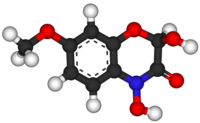This is an old revision of this page, as edited by CheMoBot (talk | contribs) at 21:23, 5 March 2011 (Updating {{chembox}} (no changed fields - added verified revid - updated 'UNII_Ref', 'ChemSpiderID_Ref', 'StdInChI_Ref', 'StdInChIKey_Ref', 'ChEMBL_Ref', 'KEGG_Ref') per Chem/Drugbox validation (). The present address (URL) is a permanent link to this revision, which may differ significantly from the current revision.
Revision as of 21:23, 5 March 2011 by CheMoBot (talk | contribs) (Updating {{chembox}} (no changed fields - added verified revid - updated 'UNII_Ref', 'ChemSpiderID_Ref', 'StdInChI_Ref', 'StdInChIKey_Ref', 'ChEMBL_Ref', 'KEGG_Ref') per Chem/Drugbox validation ()(diff) ← Previous revision | Latest revision (diff) | Newer revision → (diff) | |
 | |
| Names | |
|---|---|
| IUPAC name 2,4-Dihydroxy-7-methoxy-1,4-benzoxazin-3-one | |
| Identifiers | |
| 3D model (JSmol) | |
| CompTox Dashboard (EPA) | |
SMILES
| |
| Properties | |
| Chemical formula | C9H9NO5 |
| Molar mass | 211.173 g·mol |
| Except where otherwise noted, data are given for materials in their standard state (at 25 °C , 100 kPa).
| |
DIMBOA (2,4-dihydroxy-7-methoxy-1,4-benzoxazin-3-one) is a naturally occurring hydroxamic acid, a benzoxazinoid. DIMBOA is a powerful antibiotic present in maize and related grasses, particularly wheat and serves as a natural defense against a wide range of pests including insects, pathogenic fungi and bacteria.
In maize DIMBOA functions as natural defense against European corn borer larvae and many other damaging pests. The exact level of DIMBOA varies between individual plants but higher concentrations are typically found in young seedlings and the concentration decreases as the plant ages.